
Clematis Unveiled: Expert Advice for Stunning Vines
Published: 25/07/2024 | Updated: 03/04/2025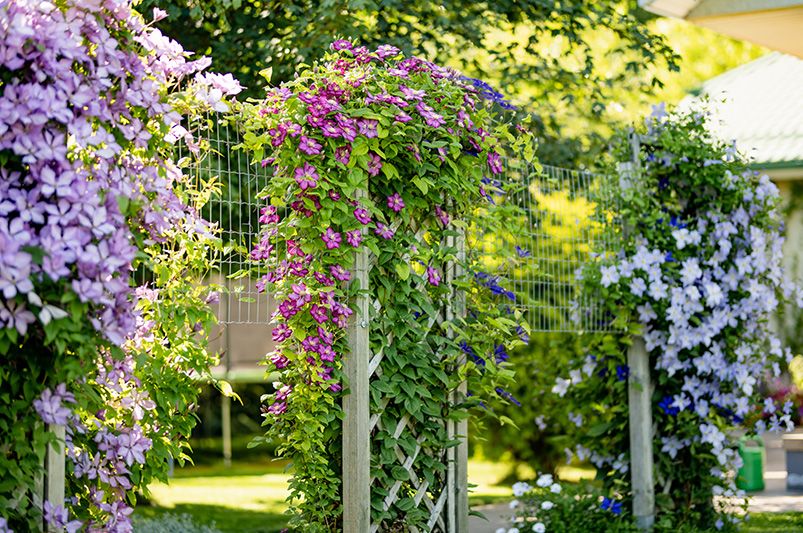
-
Clematis, the queens of the climbing plant world, thrive in sunny spots with well-drained soil.


-
Enhance soil with good organic compost and apply a thick layer of mulch to keep the roots cool.
-
Most clematis prefer full sun to partial shade for optimal blooming.
-
Provide sturdy climbing structures like trellises or netting as clematis climbs with leaf tendrils.
-
Regular watering and balanced fertilization are crucial for healthy growth and abundant blooms.
-
Prune regularly, considering the specific variety as some bloom on old wood, while others thrive on new growth.
Introduction
Clematis, known as the queens of the climbing plant world, are truly beautiful plants. They have bright flowers and graceful vines. These vigorous growers do not need much effort to thrive and can fit well in different gardens. With a little care, clematis will give you years of beautiful blooms. They can turn fences, trellises, and arbors into stunning displays of flowers.
Clematis Varieties
Exploring the realm of clematis varieties unveils a diverse tapestry of colors, shapes, and sizes. From the elegant Abilene Clematis to the charming Bijou Clematis, each cultivar offers a unique personality to adorn your garden. The majestic Boulevard Kitty Clematis and the vibrant Boulevard Volunteer Clematis stand out with their showy blooms, while the delicate Crystal Fountain Clematis enchants with its cascading flower clusters. Whether you seek a specific color palette or a certain growth habit, the world of clematis varieties is sure to have a perfect match for your gardening aspirations.

Abilene Clematis
Abilene Clematis, a stunning addition to any garden, belongs to the clematis species known for their showy flowers. These vigorous growers require a sunny spot with partial shade to thrive. To ensure optimal growth, plant them in well-draining soil enriched with good organic compost. Abilene Clematis blooms in early to late spring, offering years of joy with its beautiful flowers. Regular pruning at the end of each season promotes new growth and abundant blooms. By providing a suitable climbing structure, you can guide Abilene Clematis to its full height, creating a captivating display in your garden. Remember to support the base of the plant and mulch around the roots for a healthy and flourishing Abilene Clematis.
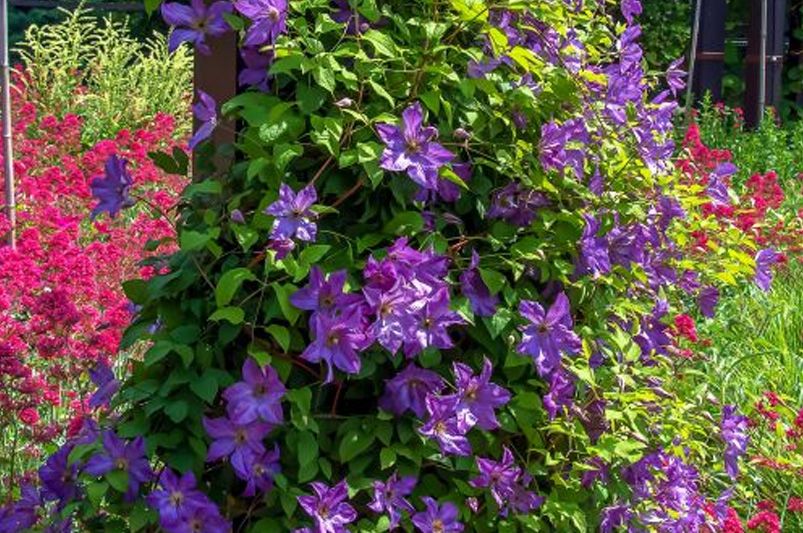
Bijou Clematis
Bijou Clematis, a charming addition to any garden, is renowned for its petite yet abundant blooms. This clematis variety, with its delicate blue-violet flowers, adds a touch of elegance to trellises and fences. To ensure the optimal growth of your Bijou Clematis, provide a sunny spot with well-draining soil and a climbing structure for its leaf tendrils to grasp. Regular feeding with good organic compost will promote vigorous growth and abundant flowering. Pruning the plant annually in early spring will help maintain its desired size and shape, ensuring a bountiful display of blooms for years to come. Embrace the beauty and grace of Bijou Clematis in your outdoor space for a touch of floral sophistication.

Boulevard Kitty Clematis
The Boulevard® Kitty Clematis is a compact, deciduous climber prized for its profusion of pale lavender to soft lilac flowers with delicate, darker central stripes. Blooming from late spring through early autumn, this variety is perfect for small spaces, patios, and containers due to its manageable size and prolific flowering habit. Part of the Boulevard® series, it is easy to care for and well-suited to both novice and experienced gardeners. It thrives in well-drained soil with plenty of sun and appreciates cool, shaded roots for optimal growth.

Boulevard Volunteer Clematis
Boulevard Volunteer Clematis brings a striking touch of beauty to the garden with its lush growth and eye-catching blooms. This vibrant climber flourishes best in a sunny location with well-drained soil, where it can stretch and thrive. Known for its vigorous habit, it can become quite assertive in the garden, so consistent care is key to keeping it in check. Regular pruning helps manage its growth and encourages fresh, flowering stems. When given the right conditions and proper support to climb, this clematis will reward gardeners with a long season of stunning flowers—making it a standout addition to any outdoor space.

Crystal Fountain Clematis
With its striking deep-blue petals and distinct bell-shaped flowers, Crystal Fountain Clematis is a favorite among gardeners. This vigorous climber can reach a height of up to 10 feet, making it an excellent choice for trellises or fences. To ensure optimum growth, plant this clematis in a sunny spot with well-draining soil and provide support for its tendrils to grasp onto. Regular watering and feeding during the growing season will promote abundant blooms. Prune this clematis in late winter or early spring to encourage new growth and maintain its shape. Crystal Fountain Clematis is a stunning addition to any garden, offering years of joy with its abundant and showy flowers.
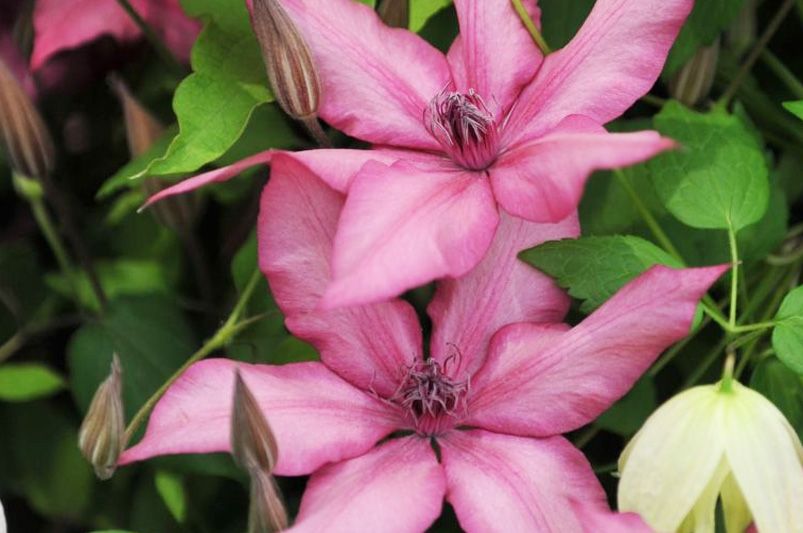
Darcy Clematis
Darcy Clematis is an exquisite variety among clematis options, featuring eye-catching flowers that can enhance the elegance of your garden. With the right care, this clematis can thrive in your outdoor area for many years, delighting you with its beauty. To promote optimal growth, place Darcy Clematis in a sunny location with well-draining soil and ensure access to a robust climbing support. Regular watering and fertilization are crucial for the healthy growth of this clematis type. Employing specific pruning techniques for clematis can assist in preserving its health and shape. By comprehending the growth requirements of Darcy Clematis, you can cultivate a vibrant vine that enriches your landscape.
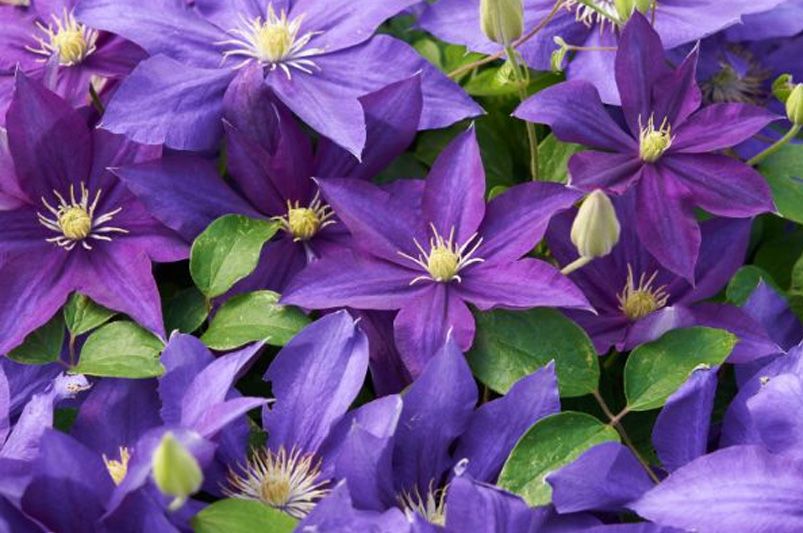
Duchess of Cornwall Clematis
The Duchess of Cornwall Clematis is a stunning deciduous climber celebrated for its large, richly colored flowers in shades of soft lavender-blue with subtle veining. Blooming from late spring through summer, this elegant variety brings a regal touch to trellises, fences, and garden walls. Its refined appearance and long flowering period make it a favorite among gardeners seeking both beauty and sophistication. Like most clematis, it prefers well-drained soil and a sunny spot with its roots kept cool and shaded.
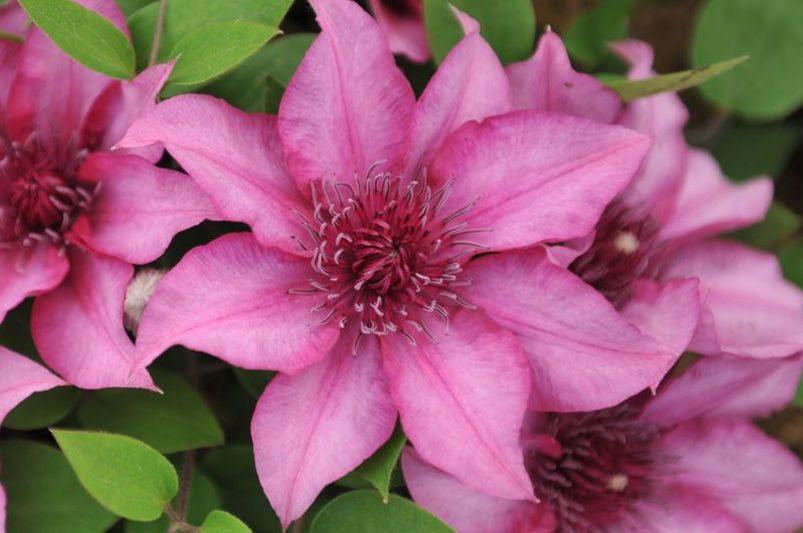
Elodi Clematis
The Elodi Clematis is a compact, deciduous climbing plant known for its striking, star-shaped flowers that bloom in shades of pink with delicate white highlights. Ideal for small gardens, containers, or trellises, it typically flowers in late spring to early summer and again in late summer. Its moderate growth habit and long-lasting blooms make it a popular choice for adding color and vertical interest to garden spaces. Elodi Clematis thrives in well-drained soil with plenty of sunlight and benefits from regular pruning to encourage healthy growth and reblooming.
Preparing Your Garden for Clematis
Before you add these beautiful climbers to your garden, you need to make the right environment for them. Good preparation will help your clematis develop strong roots and grow well. This will give you a fantastic show of flowers.
Choosing the right spot and improving the soil are some simple steps that help create a great base for your clematis to do well for many years.
Selecting the Perfect Location
When picking the right spot for your clematis, sun exposure matters a lot. These flowering plants love sunlight. They bloom best when they get at least six hours of direct sunlight each day.
But don’t worry if your garden doesn’t have many sunny spots. Clematis can grow well in partial shade too. This is especially true in warmer areas where some afternoon shade can help protect them from strong sun.
The best option is to find a place that gets morning sun and afternoon shade. This combination is great for these lovely climbers.
Soil Preparation and Requirements
Once you've found a sunny or partly shaded spot, focus on the soil. Clematis grow best in well-drained soil that holds moisture but does not become soggy. To get this balance, mix in a good organic compost when you plant.
Also, put a thick layer of mulch around the base of your clematis. This will keep the roots cool in summer and stop too much moisture from being lost. This is very important in hot areas where soil dries out quickly.
Remember, good, healthy soil means a happy clematis plant full of flowers.
Planting Your Clematis
Planting your clematis the right way is important for its health and growth. A properly planted clematis will grow strong and adapt well to its new home. This means you will enjoy more beautiful blooms throughout the season.
Knowing how deep to plant it and giving it support right away helps the roots to grow wide and allows the vines to climb. This gives your clematis a chance to live a long and colorful life in your garden.
Step-by-Step Planting Guide
Early spring is the best time for planting most clematis varieties. This time comes right after the last frost. First, dig a hole that is twice as wide and the same depth as the root ball of your plant. Then, put the clematis in the hole. Make sure the top of the root ball matches the soil around it.
Next, fill the hole back in with the improved soil. Press it down gently to remove any air pockets. Water the area well. This helps the soil settle and provides good contact between the roots and soil. Do not fertilize right after planting. It can harm the roots.
Finally, set up your climbing support structure.
Timing: When to Plant for Optimal Growth
While early spring reigns supreme, the optimal planting time for clematis can vary based on your region's climate. In areas with mild winters, late spring planting is also suitable.
The following table provides a general guideline:
|
Region |
Best Time to Plant |
|---|---|
|
Areas with Harsh Winters |
Early Spring |
|
Areas with Mild Winters |
Early Spring or Late Spring |
|
Container-Grown Clematis |
Spring, Summer, or Early Fall |
Regardless of the planting season, ensure consistent watering, especially in the first year, to encourage a robust root system. By next spring, your clematis will be well-established, ready to reward you with enchanting blooms.
Care and Maintenance of Clematis Plants
Once your clematis is settled, it's important to take good care of it. Regular watering and feeding can help your clematis save energy. This lets it grow well and produce many flowers.
Also, pruning at the right time and using the right methods can greatly affect how healthy and nice your clematis looks. It helps you shape it the way you want and encourages lots of blooms.
Watering and Feeding Your Clematis
Establishing a regular schedule for watering is very important, especially when it’s dry. Clematis plants grow best in soil that is moist but not soggy. Overwatering can cause root problems. A good rule of thumb is to water deeply once a week. This lets the water reach the roots.
Like other flowering plants, clematis needs enough nutrients to grow and bloom beautifully. In early spring, use a balanced, slow-release fertilizer when new growth begins. This helps provide the nutrients needed for the whole growing season.
You can also use a mid-season fertilizer that has a lot of phosphorus and potassium. This will help your clematis produce even more blooms.
Pruning Techniques for Healthy Growth
Pruning is very important for keeping your clematis healthy, properly shaped, and strong. However, when and how you prune depend on the type of clematis you have and when it blooms. Some clematis bloom on old wood. This means they produce flowers from last year's growth. These types usually need very little pruning.
In contrast, clematis that bloom on new growth do better with a more thorough pruning. It’s best to prune these types in late winter or early spring, right before new growth starts.
Knowing how to prune your specific clematis variety is key. It helps you get more blooms and keeps your plant healthy for a long time.
Troubleshooting Common Clematis Problems
Clematis are simple to care for, but they can face some common plant problems. These issues may include pests, diseases, wilting, and poor blooming. You can fix these easily if you identify the problem early and act quickly.
Knowing what causes the problem and using the right solutions will help keep your clematis healthy. This way, they can keep bringing joy to your garden.
Dealing with Pests and Diseases
Most clematis species are pretty strong and don't get many pests or diseases. Still, they do face some threats, with slugs and snails being the biggest problems. These slimy pests can harm young shoots and leaves, especially in humid weather. You can control them by handpicking them in the evening or sprinkling diatomaceous earth around the plants.
Another common problem is clematis wilt, which is a fungal disease. This disease can make the stems suddenly turn black and wilt. It's important to quickly prune and dispose of the affected stems to stop it from spreading.
Most clematis varieties are not invasive, but some can grow aggressively. Keep an eye on them and prune when needed to control their growth.
Overcoming Climbing and Support Challenges
Clematis are natural climbers. They use their leaf tendrils to hold onto surfaces. However, they cannot twine around thick supports like morning glories can. It is important to provide a good climbing structure to help them grow well.
You should choose structures with thin rods or mesh. This will allow the leaf tendrils to grasp effectively. Make sure the structure is strong enough to carry the weight of grown clematis because they can get quite big.
Keep an eye on how the plant grows compared to the structure. As it becomes taller and bushier, you might need to add new supports or change the existing ones to meet its needs.
Conclusion
In conclusion, growing clematis plants can be a fun and rewarding experience if you follow some simple steps. First, choose the right spot for planting. Make sure you understand the soil needs and learn how to prune correctly. This guide gives you everything you need to grow clematis successfully. Remember to water and feed your plants well. Provide support for climbing plants, and take care of any pests or diseases quickly. By using these tips, you can have a beautiful and healthy clematis garden. If you want to help other gardening fans, share this guide on social media. Happy gardening!
Frequently Asked Questions
How often should I water my clematis?
A good rule of thumb for an optimized growing environment is to water your clematis deeply once a week. Sticking to a regular schedule is a part of that care, especially in hot and dry times. But make sure to check the soil moisture before you water. Adjust how often you water if needed.
Can clematis grow in shady areas?
Clematis are flowering plants that usually like to be in full sun to grow well. However, they are not picky plants. They can also handle some partial shade. This ability to adapt is great in warmer places. A little break from the hot afternoon sun can actually help them.
What is the best time to prune clematis?
The best time to cut back your clematis depends on its type and when it flowers. If it blooms on old vines, you should prune after the flowers fade. If it blooms on new growth, you should prune in early spring, before the new shoots appear.
How can I encourage more blooms on my clematis plant?
Deadheading is when you remove faded or dead flowers from your clematis. This helps the plant make more showy flowers. It stops the plant from using energy to grow seeds. Also, be sure to fertilize your clematis well and give it enough sunlight. This will help it bloom better.
Need Assistance for a Complete Landscape Makeover?
Shrubhub’s landscape design packages can significantly transform the lives of homeowners by delivering customized, professional landscaping plans tailored to their unique space and personal style. With the ease of online collaboration, you are guided step-by-step through a design process that fundamentally reshapes your outdoor environment. The result is an aesthetically pleasing and functional outdoor living area that maximizes the potential of your property.


